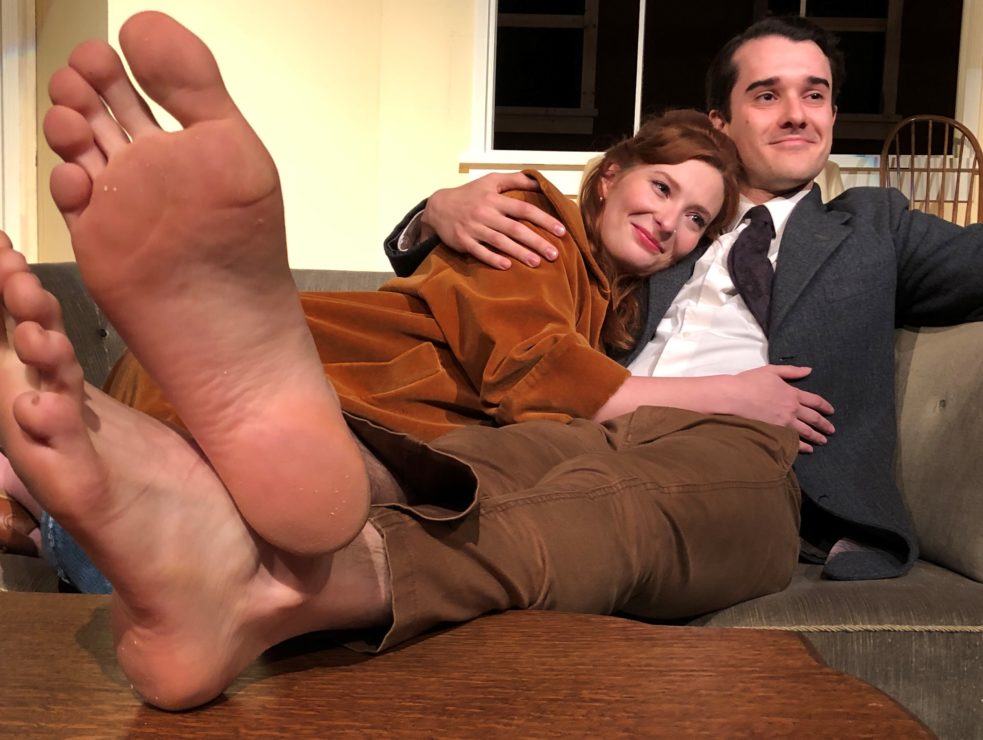Blue Bridge Repertory Theatre’s production of Neil Simon’s comedy classic will leave you breathless

Fresh from their honeymoon, seemingly incompatible newlyweds Corie and Paul Bratter do their best to settle in for the long-haul in their new fifth-floor apartment. But discord mounts as the couple contends with a backwards heater, a broken window, late furniture delivery, strange neighbours, and, of course, each other.
So begins Barefoot in the Park, the late great Neil Simon’s effervescent romantic comedy. The play premiered on Broadway in 1963 and enjoyed lasting popularity, since becoming Simon’s longest-running hit. Now playing in Victoria, the revival of this comedy classic by Blue Bridge Repertory Theatre is brimming with hysterical insights. Director Fran Gebhard has brought the aging play back to life without modernizing the performance one bit.
Laura-Jane Tresidder shines as the ever-spirited Corie Bratter, whose optimism and openness put her at odds with her “stuffed-shirt” of a husband, Paul, played by Jonathan Mason. The pair plays up their differences to great effect as they alternate between punchy banter and bickering, all the while peppering each other with Simon’s signature one-liners. Showing a deep understanding of his character, Mason successfully fills the shoes of the original Paul, Robert Redford — he’s all sense and little sensitivity, with a healthy dose of sardonic wit.
Rounding out the performance are Gwynyth Walsh as Mrs. Ethel Banks — Corie’s high-strung widowed mother — and Chris Britton as the Bratters’ insolent but charming upstairs neighbour, Victor Velasco. Both actors stand testament to the strength of Blue Bridge’s casting: Walsh convincingly juggles a mother’s endearing passive aggressive behaviour and the apprehensiveness of empty nest syndrome, while Britton is devastatingly urbane.

Though still remarkably relatable more than 50 years after its debut, Simon’s script occasionally shows its age. For example, in one scene, Corie turns to her mother for wisdom after a spectacular fight with Paul, expressing her fear for the end of their short-lived marriage. Ethel delivers, but her response is so clichéd that it falls flat on contemporary ears: “You’ve got to give up a little of you for him. Make him feel important. And if you can do that, you’ll have a happy and wonderful marriage.” Moments like this threaten to sink this buoyant comedy and require more comic back-peddling than they’re worth.
However, one of this play’s strengths is that the performance is defined by abundant motion. The players use the stage to its fullest, constantly opening and closing doors, switching places and moving objects. Every movement is perfectly choreographed, and even the set-change is gracefully conducted. In many cases, the characters’ movements are complemented by set design. For instance, Corie and Paul rush around their split-level apartment, which features two staircases on either side of the main room, thereby cleverly paralleling the couple’s everyday ups and downs.
Often, it isn’t what we see on stage but what is concealed from us that makes Barefoot in the Park so enduringly enjoyable. When characters are forced to walk up five flights of stairs to reach the apartment, they always arrive out of breath. This running joke doesn’t just build comedic tension, it also fleshes out the space outside the front door, making the one-room set feel like part of a living world. If you get the chance to take in this genuinely delightful production, you too will have a hard time catching your breath.








